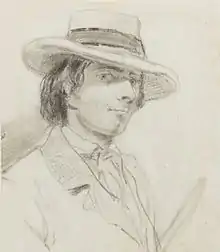Theodore Blake Wirgman
Theodore Blake Wirgman (29 April 1848 – 16 January 1925) was a British painter and etcher who moved to London, studied at the Royal Academy Schools, became a painter of history and genre subjects, and worked as a portrait artist for The Graphic. A number of these portraits are held at the National Portrait Gallery. Theodore Blake Wirgman was born in Belgium and died in London. He and his siblings, Charles Wirgman (1832–1860), Thomas Ernest (1834–1907), Francis Wirgman (1837–1860), Clara Emma (1841-1905), Helen Augusta (1843-1906), George Ferdinand (1845–1923) and Arthur David (1846–1925), were the sons of Ferdinand Charles Wirgman Russell (1806–1858) and Frances Letitia Diggins (1812–1891). The Wirgman ancestral family had been successful silversmiths who had come to London from Sweden early in the 18th century. Thomas Wirgman Upjohn, Theodore Blake's grandfather, wrote books on Kant, the German philosopher. Several of Theodore Blake's siblings died in infancy. His sister Clara E. married into the French family Thevenard, and his brother George F. emigrated to Uruguay, and had 16 children with Celedonia Guerrero Muñoz. [1][2]


He worked from a studio at 24 Dawson Place, Notting Hill, London, and joined The Arts Club in 1892.[3]
Wirgman was part of a group of avant-garde young artists who emulated Edward Burne-Jones and Simeon Solomon. This group was made up of Walter Crane, Robert Bateman, Harry Ellis Wooldridge and Edward Clifford.
References
- Britain and Japan, 1859-1991: Themes ... - Google Book Search at books.google.co.za
- DAAO Charles Wirgman at www.daao.org.au
- THE CORRESPONDENCE OF JAMES McNEILL WHISTLER Archived 2005-03-19 at the Wayback Machine
- DAAO Charles Wirgman at www.daao.org.au
Bibliography
- Bénézit, E., Dictionnaire des Peintres, Sculpteurs, Dessinateurs et Graveurs, 8 vols, Paris, 1956-61.
External links
 Media related to Theodore Blake Wirgman at Wikimedia Commons
Media related to Theodore Blake Wirgman at Wikimedia Commons- Portrait of Marjory and Dorothy Lees in the collection at Gallery Oldham.
- 13 paintings by or after Theodore Blake Wirgman at the Art UK site